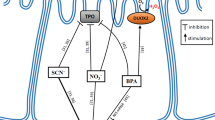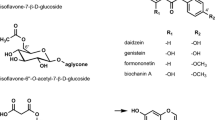Abstract
This paper reviews evidence showing iodine as an antioxidant and antiproliferative agent contributing to the integrity of normal mammary gland. Seaweed is an important dietary component in Asian communities and a rich source of iodine in several chemical forms. The high consumption of this element (25 times more than in Occident) has been associated with the low incidence of benign and cancer breast disease in Japanese women. In animal and human studies, molecular iodine (I2) supplementation exerts a suppressive effect on the development and size of both benign and cancer neoplasias. This effect is accompanied by a significant reduction in cellular lipoperoxidation. Iodine, in addition to its incorporation into thyroid hormones, is bound into antiproliferative iodolipids in the thyroid called iodolactones, which may also play a role in the proliferative control of mammary gland. We propose that an I2 supplement should be considered as an adjuvant in breast cancer therapy.
Similar content being viewed by others
Abbreviations
- H2O2:
-
hydrogen peroxide
- I2:
-
molecular iodine
- I−:
-
iodide
- I+:
-
iodinium
- I0:
-
iodine free radical
- I∗:
-
oxidized iodine species
- IO−:
-
hypoiodite
- IO3− :
-
iodate
- KI:
-
potassium iodide
- LPO:
-
lactoperoxidase
- MNU:
-
N-methyl-N-nitrosourea
- NIS:
-
sodium iodide symporter
- O2:
-
single oxygen
- O2−:
-
superoxide anions
- •OH:
-
hydroxyl radicals
- PEN:
-
pendrin
- PPAR:
-
peroxisome proliferator-activated receptor
- ROS:
-
reactive oxygen species
- T3:
-
triiodothyronine
- T4:
-
thyroxine
- TPO:
-
thyroperoxidase
References
Venturi S. Is there a role for iodine in breast disease? The Breast 2001;5:379–82.
Cann SA, van Netten JP, van Netten C. Hypothesis: Iodine, selenium and the development of breast cancer. Cancer Causes Control 2000;11:121–127.
Smyth PP. Role of iodine in antioxidant defence in thyroid and breast disease. Biofactors 2003;19:121–130.
Cocchi M, Venturi S. Iodide, antioxidant function and omega-6 and omega-3 fatty acids: A new hypothesis of biochemical cooperation? Prog Nutr 2000;2:15–9.
Thrall KD, Bull RJ. Differences in the distribution of iodine and iodide in the Sprague–Dawley rat. Fundam Appl Toxicol 1990;15:75–81.
Thrall KD, Sauer RL, Bull RJ. Evidence for thyroxine formation following iodine administration in Sprague–Dawley rats. J Toxicol Environ Health 1992;37:443–449.
Eskin BA, Grotkowski CE, Connolly CP, Ghent WR. Different tissue responses for iodine and iodide in rat thyroid and mammary glands. Biol Trace Elem Res 1995;49:9–18.
Ghent WR, Eskin BA, Low DA, Hill LP. Iodine replacement in fibrocystic disease of the breast. Can J Surg 1993;36:453–460.
Aceves C, Morales T, Pineda O, Rodón-Fonte C. Navarro L, Valverde-R C. T3 and iodine in milk. Mammary 5’deiodinase is neurally regulated. In: International symposium on hormones and bioactive substances in milk. Smolonice, Eslovak Republic; 1996; p 7.
Topper YJ, Freeman CS. Multiple hormone interaction in the developmental biology of the mammary gland. Physiol Rev 1980;60:1049–1067.
Memphan TB. Physiology of lactation. Philadelphia: Open University Press; 1987.
Tazebay UH, Wapnir IL, Levy O, Dohan O, Zuckier LS, Zhao QH, et al. The mammary gland iodide transporter is expressed during lactation and in breast cancer. Nature Med 2000;6:871–878.
Rillema JA, Williams CH, Moulden J, Golden KL. Effect of insulin on iodide uptake in mouse mammary gland explants. Exp Biol Med 2002;227:32–35.
Rillema JA, Hill MA. Prolactin regulation of the pendrin-iodide transporter in the mammary gland. Am J Physiol Endocrinol Metab 2003;284:E25–E28.
Kupper FC, Schweigert N, Ar Cali E, Legendre JM, Vilter H, Koareg B. Iodine uptake in laminariales involves extracellular, haloperoxidase-mediated oxidation of iodide. Planta 1998;207:163–171.
Hou X, Chai C, Quian Q, Yan X, Fan X. Determination of chemical species of iodine in some seaweeds (I). Sci Total Environ 1997;204:215–221.
Aceves C, Rodón C, Ramírez-C I, Wilson S, Pineda-C O, Lopez-B L, et al. Mammary 5′deiodinase (5′D) during the breeding cycle of the rat: Indirect evidence that 5′D type I is specific to the alveolar epithelium. Endocrine 1995;3:95–99.
García-Solís P, Alfaro Y, Anguiano B, Delgado G, Guzmán RC, Nandi S, Díaz-Muñoz M, Vázquez-Martínez O, Aceves C. Inhibition of induced-MNU mammary carcinogenesis by molecular iodine (I2) but not by iodide (I−) treatment. Evidence that I2 prevents cancer promotion. Mol Cell Endocrinol, in press.
Strum JM. Site of iodination in rat mammary gland. Anat Rec 1978;192:235–244.
Wynne-Edwards KE. Breast cancer etiology and prevention from an evolutionary perspective. In: Review of lifestyle and environmental risk factors for breast cancer. The Canadian Breast Cancer Initiative (CBCI). Workshop on Primary Prevention of Breast Cancer. Vol. III, Québec City, Québec Canada; 2000. p. 1–31.
Helzlsouer KJ, Couzi R. Hormones and breast cancer. Cancer 1995;76:2059–2063.
Pihan GA, Doxsey SJ. The mitotic machinery as a source of genetic instability in cancer. Semin Cancer Biol 1999;9:289–302.
Shah NM, Eskin BA, Krouse TB, Sparks CE Iodoprotein formation by rat mammary glands during pregnancy and early postpartum period. Proc Soc Exp 1986;181:443–449.
Russo J, Russo IH, Role of differentiation in the pathogenesis and prevention of breast cancer. Endocr Rel Cancer 1997;4:7–21.
Haagensen CD. Disease of the breast. Philadelphia, PA: WB Saunders; 1971. p. 62.
Yoo KY, Tajima K, Kuroishi T, et al. Independent protective effect of lactation against breast cancer: A case-control study. Am J Epidemiol 1992;135:726–733.
Yang PS, Yang TL, Liu CL, Wu CW, Shen CY. A case control study of breast cancer in Taiwan. A low incidence area. Br J Cancer 1997;75:752–756.
Newcomb PA, Storer BE, Longnecker MP, et al. Lactation and reduced risk of premenopausal breast cancer. N Engl J Med 1994;330:81–87.
Michels KB,Willett WC, Rosner BA, et al. Prospective assessment of breastfeeding and breast cancer incidence among 89,887 women. Lancet 1996;347:431–436.
Ray G, Batra S, Shukla NK, Deo S, Raina V, Ashok S, Husain SA. Lipid peroxidation, free radical production and antioxidant status in breast cancer. Breast Cancer Res Treat 2000;59:163–170.
Cook JA, Gius D, Wink DA, Krishna MC, Russo A, Mitchell JB. Oxidative stress, redox, and the tumor microenvironment. Semin Radiat Oncol 2004;14:259–266.
Szatrowski TP, Nathan CF. Production or large amounts of hydrogen peroxide by human tumor cells. Cancer Res 1991;51:794–798.
Lane DP. p53 and human cancer. Br Med Bull 1994;50:582–599.
Bos J. The ras family and human carcinogenesis. Mutat Res 1988;195:255–271.
Moraes EC, Keyse SM, Tyrell RM. Mutagenesis by hydrogen peroxide treatment in mammalian cells: A molecular analysis. Carcinogenesis 1990;11:283–293.
Rilema JA, Hill MA. Pendrin transporter carries out iodide uptake into MCF-7 human mammary cancer Cells. Exp Biol Med 2003;228:1078–1081.
Zhang L, Sharma S, Zhu LX, Kogai T, Hershman JM, Brent GA, et al. Nonradioactive iodide effectively induces apoptosis in genetically modified lung cancer cells. Cancer Res 2003;63:5065–5072.
Schmutzler C, Brtko J, Biernert K, Köhrle J. Effects of retinoids and role of retinoic acid receptors in human thyroid carcinomas and cell lines derived therefrom. Exp Clin Endocrinol Diab 1996;10:393–406.
Schreck R, Schieders F, Schmutzler C, Köhrle J. Retinoids stimulate type I iodothyronine 5′-deiodinase activity in human follicular thyroid carcinoma cell lines. J Clin Endocrinol Metab 1994;79:791–798.
Aceves C, Gopainathrao G, Rajkumar L, Guzman RC, Yang J, Nandi S. Deiodinase type 1 (D1) in N-methyl-N-nitrosourea-induced rat mammary carcinomas. Differential expression in early and late arising tumors. 84th Annual Meeting. San Francisco CA: The Endocrine Society. 2002; pp. 731.
García-Solis P, Aceves C. 5′Deiodinase in two breast cancer cell lines: Effect of triiodothyronine, isoproterenol and retinoids. Mol Cell Endocrinol 2003;201:25–32.
Teas J, Harbison ML, Gelman RS. Dietary seaweed (Laminaria) and mammary carcinogenesis in rats. Cancer Res 1984;44:2758–2761.
Yamamoto I, Maruyama H, Moriguchi M. The effect of dietary seaweeds on 7,12-dimethyl-benz[a]anthracene-induced mammary tumorigenesis in rats. Cancer Lett. 1987;35:109–118.
Funahashi H, Imai T, Tanaka Y, Tsukamura K, Hayakawa Y, Kikumori T, et al. Wakame seaweed suppresses the proliferation of 7,12-dimethylbenz(a)-anthracene-induced mammary tumors in rats. Jpn J Cancer Res 1999;90:922–927.
Kato N, Funahashi H, Ando K, Takagi H. Suppressive effect of iodine preparations on proliferation of DMBA-induced breast cancer in rat. J Jpn Soc Cancer Ther 1994;29:582–588.
Funahashi H, Imai T, Tanaka Y, Tobinaga J, Wada M, Morita T, et al. Suppressive effect of iodine on DMBA-induced breast tumor growth in the rat. J Surg Oncol 1996;61:209–213.
Brown-Grant K, Rogers AW. The sites of iodide concentration in the oviduct and the uterous of the rat. J Endocrinol 1972;53:355–362.
Mutaku JF, Poma JF, Many MC, Denef JF, van Den Hove MF. Cell necrosis and apoptosis are differentially regulated during goiter development and iodine-induced involution. J Endocrinol 2002;172:375–386.
Pisarev M, Gärtner R. Autoregulatory actions of iodine. In: Braverman E, Utiger R, editors. Werner and Ingbar’s The Thyroid. A fundamental and clinical text. Philadelphia: Lippncott-Williams & Williams, 2000; p. 85–90.
Vitale M, Di Matola T, D’Ascoli F, Salzano S, Bogazzi F, Fenzi G, et al. Iodide excess induces apoptosis in thyroid cells through a p53-independent mechanism involving oxidative stress. Endocrinology 2000;141:598–605.
Boeynaems JM, Hubbard WC. Transformation of arachidonic acid into an iodolactone by the rat thyroid. J Biol Chem 1980;255:9001–9004.
Dugrillon A, Bechtner G, Uedelhoven WM, Weber PC, Gartner R. Evidence that an iodolactone mediates the inhibitory effect of iodide on thyroid cell proliferation but not on adenosine 3′-5′-monophosphate formation. Endocrinology 1990;127:337–343.
Langer R, Buzler C, Bechtner G, Gartner R. Influence of iodide and iodolactones on thyroid apoptosis. Exp Clin Endocrinol Diab 2003;111:325–329.
Arroyo-Helguera O, Aceves C. Mecanismos de captura y actividad antiproliferativa del yodo molecular (I2) en la línea celular de cáncer MCF-7. In: XXIV Congreso Nacional de la Sociedad Mexicana de Bioquímica, Zihuatanejo, Gro. México; 2004. pp. 345.
Kliewer SA, Forman BM, Blumberg B, Ong ES, Borgmeyer U, Mangelsdorf DJ, Umesono K, Evans RM. Differential expression and activation of a family of murine peroxisome proliferator-activated receptors. Proc Natl Acad Sci USA 1994;91:7355–7359.
Shen Q, Brown PH. Novel agents for the prevention of breast cancer: Targeting transcription factors and signal transduction pathways. J Mammary Gland Biol Neoplasia 2003;8:45–73.
Kliewer SA, Sundseth SS, Jones SA, Brown PJ, Wisley GB, Koble CS, Devchand P, Wahli W, Wilson TM, Lenhard JM, Lehmann JM. Fatty acids and eicosanoids regulate gene expression through direct interaction with peroxisome proliferator-activated receptors α and γ. Proc Nat Acad Sci USA 1997;94:4318–4323.
Author information
Authors and Affiliations
Corresponding author
Rights and permissions
About this article
Cite this article
Aceves, C., Anguiano, B. & Delgado, G. Is Iodine A Gatekeeper of the Integrity of the Mammary Gland?. J Mammary Gland Biol Neoplasia 10, 189–196 (2005). https://doi.org/10.1007/s10911-005-5401-5
Issue Date:
DOI: https://doi.org/10.1007/s10911-005-5401-5




